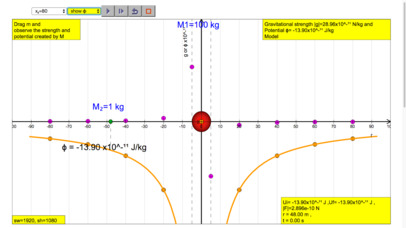
Gravity Field Potential Lab app for iPhone and iPad
About
an open source physics at Singapore simulation based on codes written by Anne Cox, Wolfgang Christian, Francisco Esquembre and Loo Kang WEE.
more resources can be found on Support URL
Introduction
Every object sets up a gravitational field and thus potential around itself due to its mass. When two objects enter each other’s gravitational fields, they will be attracted towards each other.
Hence, a gravitational field is a region of space in which any object that lies in it experiences a gravitational force towards the object that creates the field, due to its mass.
The intent of these activities is to allow students be like a student-scientists and collect their own data to form an understanding of potential energy.
The test mass (green) is at r = 100 m, observe and record the value for U r=100 = -6.67 x10-11 J
Click play and pause the model when r = 90 m, record the value of U r=90 = ____________ J
Click play and pause the model when r = 80 m, record the value of U r=80 = ____________ J
Click play and pause the model when r = 70 m, record the value of U r=70 = ____________ J
Click play and pause the model when r = 60 m, record the value of U r=60 = ____________ J
Click play and pause the model when r = 50 m, record the value of U r=50 = ____________ J
Click play and pause the model when r = 40 m, record the value of U r=40 = ____________ J
Click play and pause the model when r = 30 m, record the value of U r=30 = ____________ J
Click play and pause the model when r = 20 m, record the value of U r=20 = ____________ J
Calculate the change in U from r = 100 to r = 50.
Answer is about ΔU=-[6.67x10-11(1)(100)50-6.67x10-11(1)(100)100]=-6.67x10-9J
Check the "your model" checkbox and a teal color line appear. For example if the model is , U=-GmMr, key in -6.67*1*100/abs(r) and observe the closeness of fit of the orange color line (data collected) versus the teal color line (model proposed).
Suggest with reason why you think the model -6.67*1*100/abs(r) is accurate.
Note that the model already has a multiple of x10-11 so there is no need to key it.
This is a Lab that allows the exploration of this in a one dimensional space.
Interesting Fact
This app produce real numbers to coincident with the real world data.
Acknowledgement
My sincere gratitude for the tireless contributions of Francisco Esquembre, Fu-Kwun Hwang, Wolfgang Christian, Félix Jesús Garcia Clemente, Anne Cox, Andrew Duffy, Todd Timberlake and many more in the Open Source Physics community. I have designed much of the above based on their ideas and insights.
This research is supported by the eduLab project NRF2015-EDU001-EL021 , awarded by the Prime Minister Office, National Research Foundation (NRF), Singapore in collaboration with National Institute of Education (NIE), Singapore and the Ministry of Education (MOE), Singapore.



